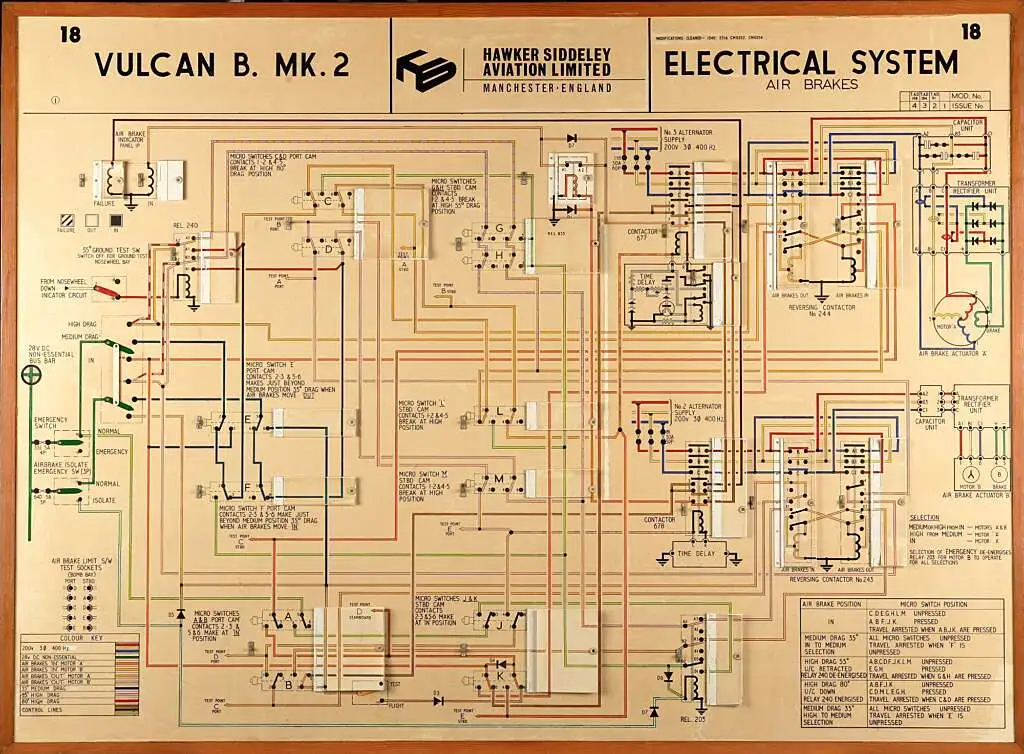From an original article by Connor Sykes – Vulcan to the Sky Trust
Approximately three months ago, Vulcan XH558 experienced an issue with inoperative airbrakes, preventing their display for most public visits this summer. While Vulcan’s airbrake system is mechanically straightforward, its electrical side is complex, involving micro-switching for automation, contactors, time delay units, power factor correction units, transformer rectifier units, and two motors (A and B). The A motor deploys the airbrakes to the ‘MEDIUM DRAG’ position, while both motors operate together to adjust between ‘MEDIUM DRAG’ and ‘HIGH DRAG’ positions or fully retract them.

The initial issue observed was that the airbrakes wouldn’t activate when set to ‘MEDIUM DRAG.’ This led the team to determine if the problem was mechanical or electrical. Mechanically, the system uses a sprocket and chain mechanism, similar to a bicycle. Both motors connect to a gearbox, which powers drive shafts and reduction gears on each side to operate the chain mechanism that moves the airbrakes. An alignment issue in these chains could prevent operation, but after examining the alignment through access panels in the engine intakes and below the aircraft, no issues were found.

Attention then shifted to the electrical system. The first step was to inspect the fuses in the synchronization bay, a section aft of the Bomb Bay where power from the alternators, APU, or RAT is distributed across various systems. Synchronization allows engines to share power, acting as a backup if one fails. The fuses were checked, and the blue-phase fuse, which had blown, was replaced. However, further inspection revealed no other issues with the power to the airbrakes. Two years prior, a capacitor unit (Power Factor Correction unit) developed a fault due to moisture exposure, causing arcing and sparking, which was another potential cause to investigate. If a similar fault had occurred, it could have led to excess current damaging the motor brushes. However, all capacitor fuses were in satisfactory condition, ruling this out as the issue.
The motors, particularly the A motor, were then suspected to be the cause. Upon operation, the system emitted a loud whining noise, but the airbrakes remained motionless—indicating a phase loss. Further inspection revealed that the red phase 50A fuse supplying the port motor had blown. After replacing this fuse, the airbrakes became operational, yet the root cause still needed identified.

The excessive voltage condition appeared to stem from the port side A motor. Diagnostic tests confirmed that all microswitches, time delay units, contactors, capacitor units, and transformer rectifier units were functioning correctly, narrowing the issue to the A motor’s brush contacts. It is anticipated that closer inspection will show signs of wear, such as carbon buildup and pitting on the brush contacts, contributing to the phase issues.

Currently, the airbrake system is operational, and replacement parts are on order to finalize repairs. Additional maintenance included lubricating seals, inspecting engines, and topping up tire pressures. Functional tests proved satisfactory; however, the bomb doors, once opened, began to creep inward, indicating a need to top up hydraulic fluid and header pressure at the next maintenance interval.
The next task will address a recent startup failure on the APU, suspected to involve the LP fuel cock, which is operated electrically by a relay. More updates on this will follow in the next report. To learn more and support the Vulcan to the Sky Trust, please visit www.vulcantothesky.org/






























